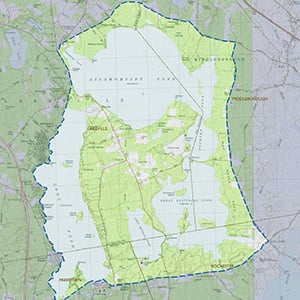Important Bird Area Sites in Massachusetts
Important Bird Area: Assawompsett Ponds Complex
Site Summary
Nominated By
Joanne Michaud
Size
10,000 acres
Towns and Counties
Lakeville, Middleborough, Rochester, Freetown; Plymouth County; Bristol County
Ownership
State, municipal, private, nongovernmental organization
Major Habitats
50% oak-conifer transitional forest, 40% lake/pond, 5% palustrine wooded swamp
Land Use
Nature & wildlife, conservation/land trust, water supply, undeveloped
Minor Threats
invasive or non-native plants
IBA Criteria
- Category 1: Sites containing assemblages of species characteristic of a representative, rare, threatened, or unique habitat within the state or region.
- Category 4: Single-species Concentrations: The site regularly supports significant concentrations of a flocking species, but may not meet the thresholds above. The site should support a higher proportion of a species' statewide population (more than 1%, if known) than other similar sites.
Site Description
The Assawompset Ponds Complex located on the Plymouth/Bristol County line is composed of Assawompset, Pocksha, Great Quittacas, Little Quittacas and Long Ponds. Long Pond is heavily developed and the only one in the complex open to public recreation, and therefore is not included within the site boundary. Assawompset and Long ponds are the two largest natural water bodies in Massachusetts, and the complex is a significant archeological site.
Current Conservation Status
All of the ponds are public water supply reservoirs for the cities of Taunton and New Bedford. Boating access to the water supply reservoirs is limited to shorefront owners only. Use of woodland roads and trails on the water supply land is allowed pursuant to the 2002 Management Plan, written by Epsilon Associates, following Lakeville's acquisition of Bettys Neck parcels and the Commonwealth's acquisition of conservation restrictions on watershed lands as of June 2002. The shores of the Quittacas Ponds are completely protected, and those of Pocksha and Assawompset are largely protected. Variable Milfoil and Fanwort continue to spread in Long and Pocksha ponds. Purple Loosestrife is well established in the emergent marsh bordering Sampsons Cove (Turner). Treatment for Variable Milfoil and Fanwort has included the use of herbicides, which may pose a threat to nontarget plants and fauna. Potential sources of pollution include shoreline development (nutrients, pesticides), road drainage (Routes 18 and 105), and fallout from the nearby SEMASS incinerator. Sand and gravel processing on Assawompset Neck may threaten ground water quality. If the estimated safe yield of the ponds is exceeded, excessive drawdown could threaten aquatic habitat. Finally, excessive use of Long Pond for personal watercraft operation could threaten the water quality of the pond complex.
Ornithological Significance
The site contains the most productive and first naturally returning pair of Bald Eagles. The ponds historically and currently have some of the highest numbers of waterfowl in the state, including: Ring-necked Duck (1,200, 1,650 annually), Lesser Scaup (85,300 annually), Greater Scaup (>570 in 2000), Ruddy Duck (363 in 1999), American Coot (445 in 1995). Ospreys returned here to nest as soon as the population began to recover, the first inland site to be colonized. Two state-listed species breed within the site, as well as at least one regional high conservation priority species.
Other Flora or Fauna of Significance
The Assawompset Pond Complex is an area of Priority Habitat for state-listed rare species, and Core Area under the Biomap Project, as designated by the Natural Heritage and Endangered Species Program. The ponds provide habitat for numerous rarities including Plymouth Gentian, Eastern Pondmussel, the Tidewater Mucket, the Bridle Shiner, and a newly introduced population of the Plymouth Redbelly Turtle. The ponds and surrounding wetlands are critical spawning habitat for one of the most productive runs of Alewives and Blueback Herring in the Northeast.
Data Sources
Veit, R.R. and W.R. Petersen. 1993. Birds of Massachusetts. Massachusetts Audubon Society, Lincoln.
Petersen, Wayne R. 1994. "Bridgewater, Middleboro, and Lakeville" in A Birder's Guide to Southeastern Massachusetts, American Birding Association.
Records from Bird Observer (1994-2000)
Massachusetts Breeding Bird Atlas (1974-1979)
Lakeville Open Space and Recreation Plan, 2001, Lakeville Open Space and Recreation Plan Subcommittee
Turner, Richard E., MA DFW, personal communication with J. Michaud




